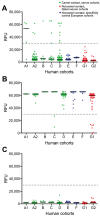Occupational Exposure to Dromedaries and Risk for MERS-CoV Infection, Qatar, 2013-2014
- PMID: 26196891
- PMCID: PMC4517733
- DOI: 10.3201/eid2108.150481
Occupational Exposure to Dromedaries and Risk for MERS-CoV Infection, Qatar, 2013-2014
Abstract
We determined the presence of neutralizing antibodies to Middle East respiratory syndrome coronavirus in persons in Qatar with and without dromedary contact. Antibodies were only detected in those with contact, suggesting dromedary exposure as a risk factor for infection. Findings also showed evidence for substantial underestimation of the infection in populations at risk in Qatar.
Keywords: MERS; MERS-CoV; Middle East respiratory syndrome coronavirus; Qatar; camels; contact; coronavirus; dromedaries; epidemiology; exposure; infectious; risk; transmission; viruses; zoonoses.
Figures

References
-
- World Health Organization. Disease outbreak news. Middle East respiratory syndrome coronavirus (MERS-CoV)—Qatar. 2015. Mar 11 [cited 2015 Mar 19]. http://www.who.int/csr/don/11-march-2015-mers-qatar/en/
MeSH terms
Substances
LinkOut - more resources
Full Text Sources
Other Literature Sources
Medical

